
Browse an alphabetical list of photographs. These historical images portray people, places, and events before, during, and after World War II and the Holocaust.
<< Previous | Displaying results 351-400 of 2641 for "Photo" | Next >>
"Aryanization" of Jewish-owned businesses: a formerly Jewish-owned store (Gummi Weil) that was expropriated and transferred to non-Jewish ownership (Stamm and Bassermann). Frankfurt, Germany, 1938.
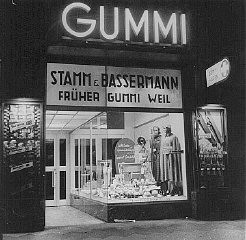
One of many piles of ashes and bones found by US soldiers at the Buchenwald concentration camp. Germany, April 14, 1945.
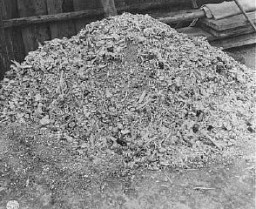
After Adolf Hitler became chancellor of Germany, he persuaded his cabinet to declare a state of emergency and end many individual freedoms. Here, police search a vehicle for arms. Berlin, Germany, February 27, 1933.
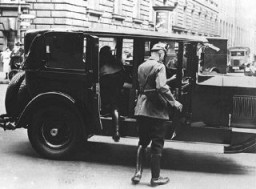
An assembly point (the Umschlagplatz) in the Warsaw ghetto for Jews rounded up for deportation. Warsaw, Poland, 1942–43.
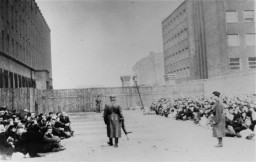
Former prisoners of Wöbbelin, a subcamp of Neuengamme, are taken to a hospital for medical attention. Germany, May 4, 1945.
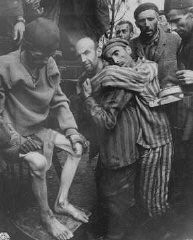
Children sit and sleep on the floor at Sisak, a Ustasa (Croatian fascist) concentration camp for children. Yugoslavia, during World War II.
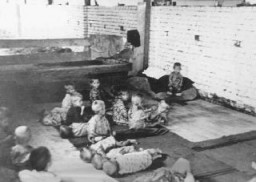
Two women and a child stand with metal bowls in front of a soup kitchen in the Cremona displaced persons (DP) camp in Italy, 1945. Pictured are Zelda Leikach and her daughter, Masha, with their friend Hinda.

Athletes Jesse Owens of the United States (right) and Lutz Long of Germany at the Olympic stadium. Berlin, Germany, 1936.
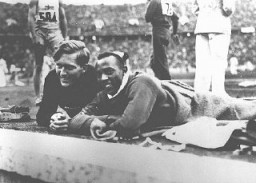
Smoke billows out from US ships hit during the Japanese air attack on Pearl Harbor, Hawaii, December 7, 1941.
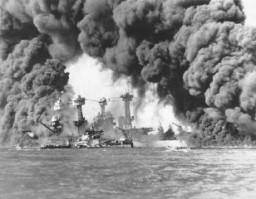
The damaged car of SS General Reinhard Heydrich after an attack by Czech agents working for the British. Prague, Czechoslovakia, May 27, 1942.
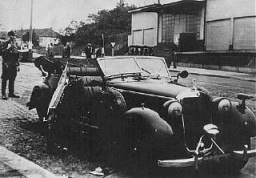
Carl Heinrich Langbehn was an attorney who was slated for a possible cabinet seat had the July 1944 attempt on Hitler's life succeeded. He is pictured here on trial before the People's Court in Berlin. Langbehn was executed in the Ploetzensee prison on October 12, 1944.
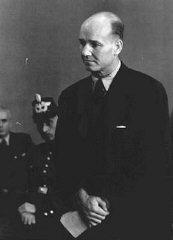
Augusta Feldhorn stands next to a nun while in hiding. Augusta, a Jewish child, was in hiding under an assumed Christian identity. Belgium. 1942-1945.
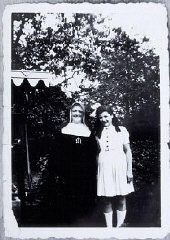
View of a section of the barbed-wire fence and barracks at Auschwitz at the time of the liberation of the camp. Auschwitz, Poland, January 1945. On January 27, 1945, the Soviet army entered Auschwitz, Birkenau, and Monowitz and liberated more than six thousand prisoners, most of whom were ill and dying.
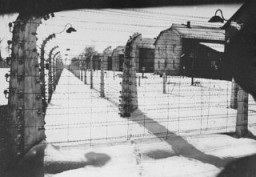
This photograph shows Auschwitz fence posts and a quote from Elie Wiesel's Night . They are on display in the third floor tower room of the Permanent Exhibition at the United States Holocaust Memorial Museum. "Never shall I forget that night, the first night in camp, which has turned my life into one long night, seven times cursed and seven times sealed. Never shall I forget that smoke. Never shall I forget the little faces of the children, whose bodies I saw turned into wreaths of smoke beneath a silent…
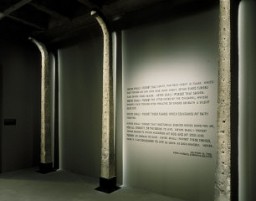
Austrian Jewish children being transported to the United States by Eleanor and Gilbert Kraus perform a life jacket drill aboard the ship President Harding. June 1939.
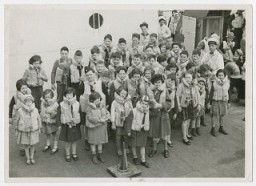
Austrian Jewish refugee children, members of one of the Children's Transports (Kindertransport), arrive at a London train station. Great Britain, February 2, 1939.
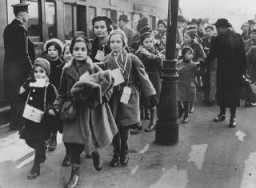
Prisoners from Austria, marked with triangles and identifying patches, in the Dachau concentration camp. Germany, April 1938.
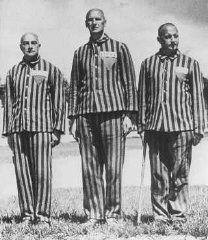
After the Anschluss (German annexation of Austria), Austrian Jewish refugees disembark from the Italian steamship Conte Verde. Shanghai, China, December 14, 1938.
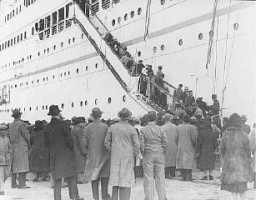
Max Brod, a Czech-born Jewish author and composer who wrote in the German language. An active Zionist, he succeeded in leaving for Palestine in 1939. Prague, Czechoslovakia, February 27, 1937.
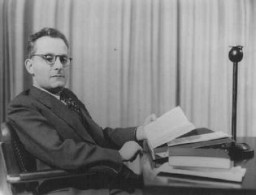
Thomas Mann, seen here in Germany before the war, was a noted German novelist and Nobel Laureate. He denounced the Nazis and emigrated to the United States in 1938 after his German citizenship was revoked. Germany, prewar.
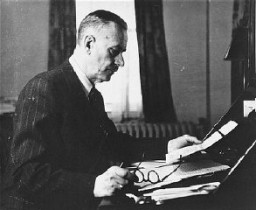
An ORT (Organization for Rehabilitation through Training) auto mechanics class at Landsberg displaced persons camp. This training prepared the students to emigrate to Palestine. Germany, postwar.
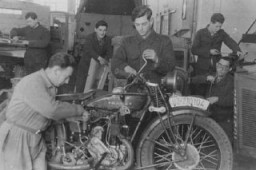
Secretary of the Kovno ghetto Jewish council Avraham Tory stands with Zvi Brik (left), workshop administrator, in the cemetery of the Kovno ghetto. Kovno, Lithuania, 1943.
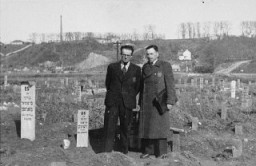
Children stand at attention during a flag raising ceremony at the Ayindram Betar summer camp. Tunisia, North Africa, 1946.
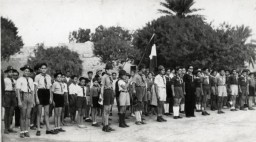
A young baby sits in its carriage next to a Quonset hut in Babenhausen displaced persons camp. Babenhausen, Germany, 1946-47.
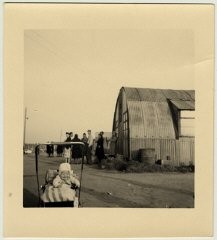
On September 29-30, 1941, SS and German police units and their auxiliaries, under guidance of members of Einsatzgruppe C, murdered the Jewish population of Kiev at Babi Yar, a ravine northwest of the city. This photograph shows groups of Jews being forced to hand over their possessions and undress before being shot in the ravine.
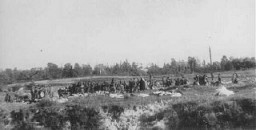
This photograph shows Dina Sarna in front of a sign saying "Jewish DP Camp" in the Bad Reichenhall camp for Jewish displaced persons. Bad Reichenhall, Germany, 1947.
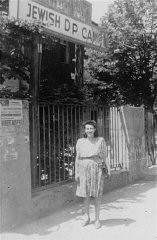
Hitler Youth leader Baldur von Schirach speaking at the opening of the Reich Academy for Youth Leadership. Braunschweig, Germany, June 4, 1938.
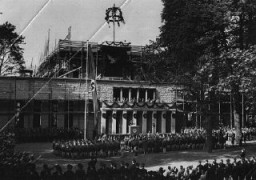
View of a barbed-wire fence separating part of the ghetto in Krakow from the rest of the city. Krakow, Poland, date uncertain. During the Holocaust, the creation of ghettos was a key step in the Nazi process of brutally separating, persecuting, and ultimately destroying Europe's Jews. Ghettos were often enclosed districts that isolated Jews from the non-Jewish population and from other Jewish communities.
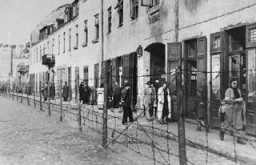
A view of the double row of barbed-wire fences that surrounded the Ohrdruf camp, a subcamp in the Buchenwald camp system. Ohrdruf, Germany, April 1945.
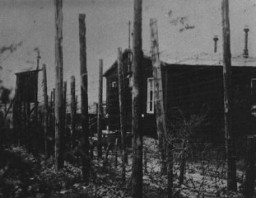
A section of barbed-wire fencing surrounding the Plaszow camp. Plaszow, Poland, 1943-44.
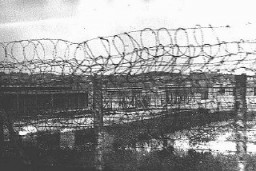
Barracks for prisoners at the Flossenbürg concentration camp, seen here after liberation of the camp by US forces. Flossenbürg, Germany, May 5, 1945.
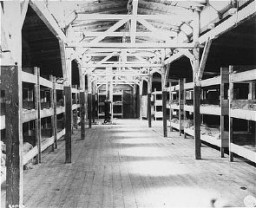
Interior view of prisoners' barracks at the Ohrdruf subcamp of the Buchenwald concentration camp. This photograph was taken after liberation. Ohrdruf, Germany, April 13, 1945.

View of barracks in the women's camp in the Auschwitz-Birkenau killing center in German-occupied Poland, 1944.
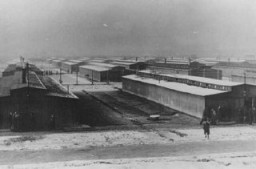
Barracks in the Auschwitz-Birkenau camp. This photograph was taken after the liberation of the camp. Auschwitz-Birkenau, Poland, after January 29, 1945.
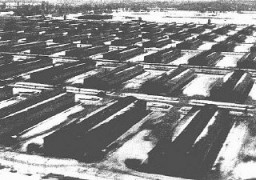
View of barracks after the liberation of Kaufering, a network of subsidiary camps of the Dachau concentration camp. Landsberg-Kaufering, Germany, April 29, 1945.
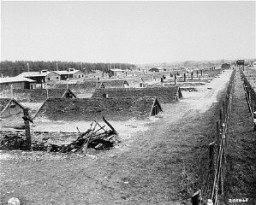
A view of barracks in the Kaufering network of subsidiary camps of the Dachau concentration camp. Landsberg-Kaufering, Germany, after April 27, 1945.

A view of barracks in the Buchenwald concentration camp. This photograph was taken after the liberation of the camp. Buchenwald, Germany, after April 11, 1945. Buchenwald, along with its subcamps, was one of the largest concentration camps established within the old German borders of 1937.
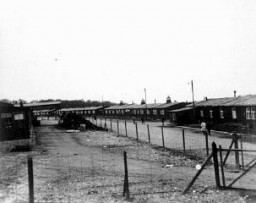
The interior of a barracks at the Westerbork transit camp, after liberation. Westerbork, the Netherlands, after April 12, 1945.
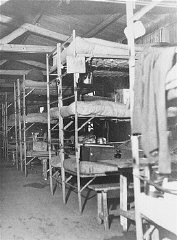
Troops supporting Hitler arrive in Munich during the Beer Hall Putsch on November 9, 1923.
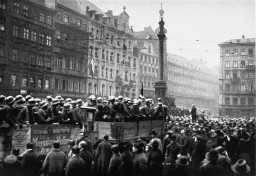
A runner begins the torch relay (the first "Olympia Fackel-Staffel-Lauf") in Oympia, Greece., ca. July 1936. The 1936 Games were the first to employ the torch run. Each of 3,422 torch bearers ran one kilometer (0.6 miles) along the route of the torch relay from the site of the ancient Olympics in Olympia, Greece, to Berlin. Former German Olympian Carl Diem modeled the relay after one that had been run in Athens in 80 B.C. It perfectly suited Nazi propagandists, who used torchlit parades and rallies to…
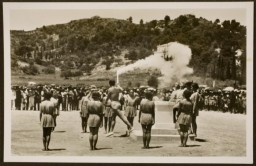
Cover to György Beifeld's album, featuring a road sign with the Hungarian Labor Service company number 109/13 posted in a muddy wasteland. The Jewish labor servicemen were forced to construct roads on these muddy fields to accommodate the advance of the Hungarian 2nd Army toward the Don River.
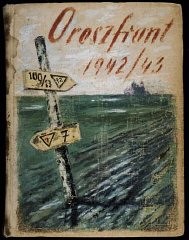
In a take-off of travel posters advertising peaceful vacation spots, Beifeld draws a picture of a Hungarian military tent pitched next to a tree on which a bird is cheerfully chirping. Next to the tent the artist writes "Peaceful Surroundings" but above, a Soviet bomber releases a bomb aimed at the tent. [Photograph #58022]
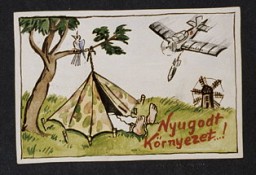
Belongings of a Jewish family murdered by an SS mobile killing squad at Babyn Yar. On September 29-30, 1941, the SS killed more than 33,000 Jews from Kyiv (Kiev). A German Propaganda Company photographer took this image within days of the massacre. Kyiv, German-occupied Soviet Union, after September 30, 1941.

Clothing belonging to Jewish victims murdered by the SS at the nearby Babyn Yar killing site. Prior to the mass shootings, the SS ordered Jews to undress and leave their belongings. They then marched or drove the victims to the killing site. A German photographer took this image within days of the mass shootings. Kyiv (Kiev), German-occupied Soviet Union, after September 30, 1941.
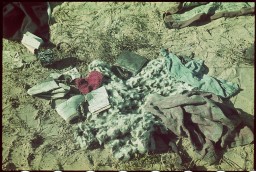
The SS ordered Jews to undress prior to the mass shootings at the nearby Babyn Yar killing site. In two days, September 29-30, 1941, they shot more than 33,000 Jews from Kyiv (Kiev). This photograph, taken by a member of a German Propaganda Company, shows just some of the belongings of these victims. Kyiv, German-occupied Soviet Union, After September 30, 1941.
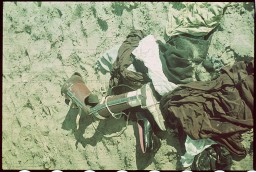
Belongings of Jews who were deported from Vienna. Austria, 1941–42.
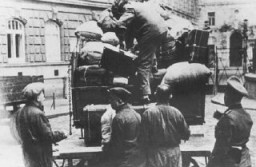
Ben Kamm in uniform after the war. Ben escaped from the Warsaw ghetto and joined partisan units to resist the Nazis. At the end of the war he discovered he was the sole survivor of his entire family.
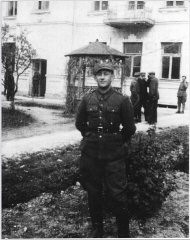
Benito Mussolini and Adolf Hitler stand together on an reviewing stand during a official visit to occupied Yugoslavia, 1941–43.
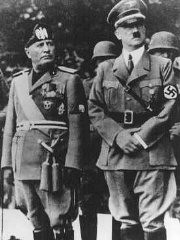
Benjamin Meed (right) and Harvey Meyerhoff stand next to the cornerstone for the United States Holocaust Memorial Museum. In October 1988, President Ronald Reagan spoke at a special ceremony held when the cornerstone of the Museum was laid, with construction beginning in July 1989 and ending in April 1993. Washington, DC, 1988.
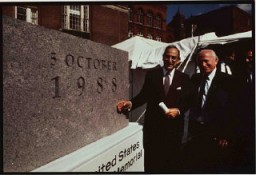
While living in hiding on the Aryan side of Warsaw, Benjamin Miedzyrzecki (Ben Meed) returns to the site of the Warsaw ghetto, where he poses among the ruins. Warsaw, Poland, 1944.

We would like to thank Crown Family Philanthropies, Abe and Ida Cooper Foundation, the Claims Conference, EVZ, and BMF for supporting the ongoing work to create content and resources for the Holocaust Encyclopedia. View the list of donor acknowledgement.